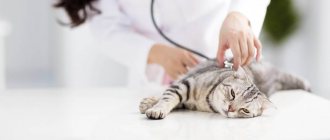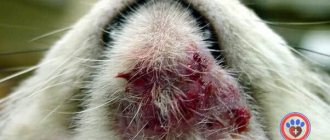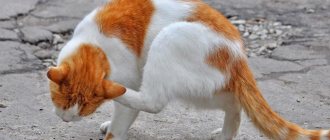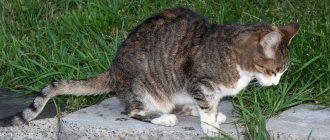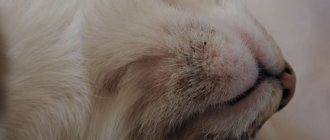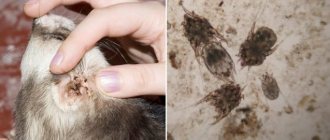- What causes acne?
- How does acne appear?
- Modern approaches to acne treatment
The appearance of black dots on a cat's chin does not cause concern to every pet owner. This approach to the condition of a pet’s skin is easily explained by the fact that blackheads or acne, it would seem, do not in any way affect the cat’s health and do not affect its general well-being. In fact, acne in cats, the treatment of which must be comprehensive, indicates not only health problems in the pet. In cases of bacterial infection, inflammation may develop with the formation of purulent foci, subcutaneous abscesses, phlegmon, and the like.
How can you treat acne in cats?
In the fight against this disease in four-legged furry patients, areas of inflammation are sometimes treated with a two-phase liquid makeup remover. By carefully soaking a cotton swab in this product, you need to remove dirt and excess sebum - this is an excellent disinfection. This method is used only if there is no inflammation or pustules. Also, in the absence of wounds and ulcers, the use of folk remedies is allowed - you can treat acne with a composition of two furatsilin tablets mixed with pumpkin juice or boiled chamomile. In this case, lotions made from medicinal herbs – yarrow or celandine – can be effective.
In cases where acne is caused by allergies, switching to a different food or replacing plastic utensils with other materials - earthenware or metal - can help.
Varieties
Unnoticed blackness in the beard area of a pet in time can lead to the formation of purulent wounds, in place of which a crust will subsequently form. Fungus, bacteria and other pathogenic microorganisms grow in the wound, causing a purulent-inflammatory process. The table shows the main types of sores in cats in the chin area:
| Type of ulcers | Peculiarities |
| Surface | Are the result of scratches or shallow bites |
| The skin becomes reddish and a white dot appears on it | |
| Mostly the abscess opens on its own and does not require any treatment. | |
| Deep | Manifest against the background of bites with damage to the deep layers of the epidermis |
| The damaged surface of the skin is very painful, but in appearance it is not very different from healthy | |
| When palpating, a compacted area is noticed | |
| Spicy or hot | The inflammatory response develops quickly |
| There is a red wound, in place of which a crust appears | |
| Cold | Accompanied by a deep abscess, which has a chronic course |
| Such ulcers are permanent and may not go away for several years. | |
| Often recur | |
| Benign | Purulent discharge contains many living leukocytes |
| The cat's immune system rejects the affected areas, resulting in thick, white pus that does not have a strong odor appear on the chin. | |
| Malignant | White blood cells in the exudate die off or are very weak, while the cancer cells are strong |
| If purulent spots are not eliminated in a timely manner, phlegmon develops. |
Cat acne on the chin
Acne on the cat's chin is one of the most common skin diseases in cats of any gender and age. Symptoms range from almost invisible comedones to extremely inflamed ones. Depending on the course of the disease, cats behave differently. Some people don't react at all to the appearance of pimples, while others experience itchy pain and get nervous.
Where acne appears on the chin, hair loss and redness of the skin can be observed. At the first stage, you may notice a slight “dirtyness” - this effect is created by black dots between the hair follicles. Often everything is limited to this symptom, but sometimes it can turn into swollen red lumps that rupture and bleed.
Why worry: main reasons
According to veterinarians, the main source that causes sores on the beard containing pus to appear is impaired function of the sebaceous glands.
Abscesses, scabs and ulcers on the lower jaw in kittens and adult cats are not uncommon and appear under the influence of external or internal factors. The second type includes the following reasons:
- frequent stress, as a result of which the sebaceous glands work with greater intensity;
- improper development of subcutaneous structures;
- weak defense mechanisms of the immune system.
Poor hygienic conditions provoke the development of many diseases.
Often, after eating a pet, grains or dirt remain on the pet’s fur, as a result of which a red, inflamed spot or purulent wound later forms. If the owners do not carefully monitor the pet’s hygiene and do not regularly clean its feeding dishes, then a lot of bacteria accumulate on its surface, they spread to the chin and the skin festers. A violation may also occur if the pet is rarely bathed. Cats of any breed are at risk, and experts note that sterilized individuals are less likely to suffer from ulcers and other wounds.
Effective treatment: ointments for acne in cats
Obviously, for recipes to combat acne in our pets, we need to turn to professionals. Local remedies are usually prescribed, which can be quite effective if used regularly - once every one to three days, or as needed. This is primarily mupirocin in the medicinal form of an ointment or cream. A gel with 2.5% benzoyl peroxide is also used - keep in mind that this product may cause irritation in some cats. Another drug for cat acne is a gel with a 075% metronidazole content, as well as a lotion or cream with a 0.01% -0.025% tretinoin content. Local preparations containing tetracycline, clindamycin, or erythromycin have also proven effective.
Preventive measures
To prevent black spots from popping up on your cat's face, you need to follow some prevention rules. It is worth surrounding your pet with care and attention so that it does not experience stress and other negative emotions that can affect the condition of its skin. It is important to feed your pet good, high-quality food that contains sufficient amounts of vitamins and beneficial microelements so that the cat’s immunity does not weaken.
In preventing ulcers in the chin area, it is important to keep your pet clean. It is necessary to clean the bowl regularly. It is better to give food from a metal bowl, since plastic absorbs pathogenic microorganisms that will be transmitted to the cat during the next meal. The chin is a difficult place to clean, so your pet cannot always clean it on its own after eating or walking outside. Owners are required to monitor this area and clean it if necessary. When bathing the animal, special shampoos are used.
Causes of perioral dermatitis
Various factors become prerequisites for the occurrence of the disease. It is generally accepted that the disease can occur in waves, during which the irritation on the skin passes and reappears. Doctors often identify hormonal changes as the cause of perioral dermatitis. Symptoms appear as a result of:
- the use of drugs based on corticosteroids, which provoke the occurrence of rosacea, acne, blackheads and other cosmetic problems
- pregnancy, when the body is at the stage of serious changes and hormonal changes. Dermatitis often worsens before the onset of menstruation.
- using inappropriate decorative cosmetics
- the use of pastes with fluoride, which provoke irritation of the epidermis
- chapping after walking in the cold or sunbathing
- infectious diseases
- problems with immunity. They are usually caused by not getting enough vitamins.
Having discovered a corresponding problem, it is better to immediately go to see a doctor and find out how to treat perioral dermatitis on the face in adults.
Bibliography
- Adaskevich V.P. Perioral dermatitis: clinical picture, diagnosis, treatment / V.P. Adaskevich // Dermatology. – 2008. – No. 1. – P. 17–20.
- Grashkin V. A. Diagnostic criteria, epidemiology and substantiation of clinical and pathogenetic types of perioral dermatitis / V. A. Grashkin, M. S. Gromov // Voenmed. magazine – 2010. – No. 10. – P. 32–45.
- Rodionov A. N. Dermatocosmetology. Lesions of the facial skin and mucous membranes. Diagnostics, treatment, prevention / A. N. Rodionov. – St. Petersburg. : Science and technology, 2011. – 912 p.
- Karelina O. Yu. Perioral dermatitis: treatment with azelaic acid / O. Yu. Karelina, Yu. M. Karelin // Klin. dermatology and venereology. – 2006.
Diagnosis of diseases
Determining the exact cause that triggered the formation of scabs on a cat’s neck can only be determined by a qualified veterinarian. First of all, the doctor collects an anamnesis, determining when the first characteristic signs of lesions appeared.
Perhaps the appearance of itching and sores is seasonal, or the animal is on medication.
Next, laboratory tests are prescribed - a general clinical blood test, blood biochemistry, and a biopsy from the affected areas of the skin. Of no small importance in diagnosing sores on a cat’s neck is an examination under a special ultraviolet lamp.
If pyoderma is suspected, scrapings from the damaged parts and smears are performed for further examination under a microscope.
Traditional treatment scheme
Veterinarians claim that with proper treatment of isolated cases of acne, a complete recovery of the animal is possible without relapses.
If comedones reappear, the cat will most likely need lifelong treatment and daily hygiene procedures.
When the disease is in an advanced stage, bloody scratches form in place of the blackheads and a secondary infection occurs - a fungal or bacterial infection of the skin. Timely contact with a veterinarian and comprehensive therapy will help prevent the disease from developing serious complications.
In complex treatment, the following drugs and procedures are prescribed:
- Antiseborrheic shampoos such as Lactaderm and Doctor. They contain sulfur, salicylic acid, benzoyl peroxide, ethyl lactate, which help remove fat and dirt and have a drying effect. Wash the animal once or twice a week.
- Products with local cleansing and antiseptic effects. This could be Chlorhexedine, Furacilin solution, Miramistin, hydrogen peroxide. In addition to disinfection, these drugs help relieve itching.
- Brilliant green or iodine - applied to the affected area after antiseptic treatment, dried and disinfected comedones.
- Ointments and gels with anti-inflammatory and drying effects - Flucinar, Levomekol, Tetracycline, Leniment synthomycin, syntomycin and zinc.
- Antibacterial ointments or gels, such as Mupirocin, Flemoxin salutab or Bactroban.
- Combined preparations in the form of ointments with benzoyl peroxide and antibiotic (Baziron, Zinerit).
- Retinoid ointments with vitamin A (Differin, Adacoin) have an immunomodulatory and anti-inflammatory effect, preventing follicle blockage.
- Systemic antibiotics are prescribed only in difficult cases - when blackheads turn into ulcers, follicles and infected wounds. 90 percent of acne diseases are cured without antibacterial injections. Amoxicillin, Enrofloxacin, and cephalosporins are usually prescribed.
Treatment of perioral dermatitis
A confirmed diagnosis usually requires an integrated approach. The treatment regimen involves a complete refusal of cosmetics, as well as corticosteroid drugs. The patient is advised to use antihistamines to relieve burning and itching. Herbal lotions are used to help reduce inflammation. Reflexology is used to stop symptoms by pressing on specific points or placing special needles.
Having weakened the symptoms, you can resort to the use of antibiotics to get rid of the infection if it is diagnosed during the examination. For perioral dermatitis, medications are prescribed by a doctor taking into account age, body characteristics, allergies and pregnancy. Strengthening the immune system and restoring the balance of intestinal microflora are important. The latter may require a specific diet. Avoid fried, spicy and fatty foods, snacks, sweets and fast food. Give up alcohol and cigarettes.
Clinical features
Usually acne appears asymptomatically, so it is not possible to notice it right away. If the cat is not eating well, suffers from allergies or chronic diseases, the rashes will soon become more numerous. Progression of the pathology is possible with weakened immunity.
Clinical signs of acne:
- the appearance of white or black spots on the chin or near the lips;
- in advanced cases, hair begins to fall out in the affected area;
- later skin itching is noted, the cat is constantly itching;
- sometimes local suppuration occurs.
If left untreated, complications may occur, so you should contact your veterinarian right away. An urgent, detailed examination is required, which is carried out by a doctor in a clinical setting.
We will help you cure your pet. Call 33-94-45!
Characteristics of acne
Acne is a condition caused by excessive sebum production. Such a malfunction occurs when the sebaceous glands are disrupted, and the result is blackheads, blackheads and pimples.
Very often, skin problems occur in areas that the animal is not able to clean thoroughly naturally, such as the chin, belly, or near the ears.
With proper treatment, it does not pose a threat, being mostly a cosmetic problem.
However, if the disease is neglected, it can develop into dermatitis , which will require more serious treatment. In addition, there is a risk of secondary infection if the cat scratches the affected areas.
Some owners may be concerned about the question: is this condition contagious to humans? No, cat acne is not transmitted to humans or other animals, since its occurrence is caused by a malfunction of the sebaceous glands without the participation of bacteria or viruses.
Causes
Veterinarians are still debating the causes of this disease. Today, there are several main factors that can provoke the appearance and development of acne:
- Stress. This phenomenon is also characteristic not only of people, but also of animals, as a result of which problems in the functioning of the sebaceous glands may arise.
- Pathologies of the development of the sebaceous glands. This is often an innate characteristic of a particular animal.
- Hormonal imbalances.
- Painful conditions of the cat. In particular, these include reduced immunity, skin diseases, etc.
- Allergic reactions.
Acne can also occur due to improper care: an abundance of fatty foods, infrequent washing of cat bowls, insufficient bathing of the animal.
Often the chin is one of those areas that the cat is not able to thoroughly wash on its own, so the owner’s help is required.
Main symptoms
Acne most often manifests itself with a number of characteristic symptoms that increase as the disease progresses. As a rule, these are the following groups of signs:
- Black dots. The first sign of skin problems that you should pay attention to is that blackheads tend to grow. Large clumps may appear as dirty spots on the fur.
- Skin redness and swelling.
- Pimples. Typically, acne in cats is also accompanied by the appearance of small pimples with white tips. Over time, their number may increase.
- Ulcers, nodules. If measures to treat the disease are not taken in time, skin inflammation will gradually progress to the stage of ulcers and painful nodes.
- Itching. Often the appearance of acne is accompanied by painful itching, forcing the cat to scratch the skin until the wounds become bloody.
- Baldness. If the disease is neglected too much, sooner or later the hair on the affected areas will begin to thin out significantly, which threatens complete baldness.




